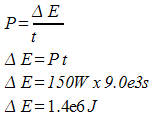Work
The everyday definition of “work” and the one that we use in physics are quite different from each other.
- When most people think about “work” they think of the job that they have.
- In physics we define work two different ways.
Definition 1:
Work is a transfer of energy, either from object to object, or from one type of energy to another.
Definition 2:
Work is a force exerted on an object that causes it to have a displacement in the same direction.
- This second definition has a formula that goes along with it. Although it is simple, treat it with respect. It's sort of like the F = ma formula; simple, but applicable to many different situations.
W = F d
W = work (Joules)
F = force (Newtons)
d = displacement (metres)
By definition, 1 J of work is done by applying 1 N of force to move an object 1 m.
- Work has no direction, so it is a scalar quantity.
- Also, the direction of motion must be in the same direction (parallel) as the direction of the force, otherwise no work is being done.
Example 1: I am holding a 2 kg block of cheese in my hands. I walk 12 m to the other side of the room. Explain if I did any work.
Since I am holding the cheese up against gravity, the force I must be exerting on it will be pointing up. I moved horizontally, so the two vectors (force and displacement) are perpendicular to each other. I did not do any work.

Example 2: I decide to get my pet frog to do a little weight lifting (but I’m going to start him off slow!). He lifts 10 kg up from the floor, over his head, and back down to the floor. Explain if he did any work.
Well, in this case the force must be pointing up when he lifts up the weights, and at first he's moving them up, so everything seems fine so far. But wait… I said that he then brings the weights back down to the floor. Overall, the displacement of those weights is zero! Therefore he didn’t do any work.
Example 3: Last winter my car got caught in a snow bank. I promise one of my friends that if he comes over to do some work for me, I’ll buy him a Whopper (with extra onions… he really likes onions). We get behind the car and push it out of the snow. Explain if I owe him a Whopper.
In this situation, both of us were pushing in the same direction (parallel to each other) and the car moved in that direction. So the answer would be “Yes!” I do owe him a whopper for the work he did… but I’ll cut it in half and eat part of it myself since I did half the work.
To actually do any standard calculations of work is pretty straight forward using the formula.
- Just make sure that as you start any question, you make sure that the force and the displacement are in the same direction.
Example 4: My daughter, Katrien, grabs my son, Niels, by the foot and drags him 2.3 m across the floor. If she exerted a force of 18.1 N to do this, determine how much work she did.
W = F d = 18.1 N (2.3 m) = 42 J
When you look at the answer you just calculated, you’ll also want to keep in mind the first definition of work.
- Since work is a transfer of energy it applies to the example above. Katrien is transferring chemical energy stored in her body into kinetic energy of Niels going across the floor.
- This definition is also useful if you know something about how energy is changing forms.
We sometimes call the total energy of an object (potential and kinetic) the mechanical energy of an object.
- This would mean that doing work on an object in some way changes the mechanical energy of the object.
- “Mechanical” energy doesn’t mean that it always has to involve machines.
- In fact, most of the time it has nothing to do with a machine.
- An apple falling off a cliff has potential and kinetic energy, so it therefore has mechanical energy.
- We will look at mechanical energy in detail in the next lesson.
Power
The word “power” is most often associated with electricity in everyday use, but this is not the case in physics.
- Power is the rate at which work is done.
- This means that power measures how quickly energy is being used.
- Since it is the rate at which something is happening, time must be involved somehow.
- If you look at the basic formula for power, you’ll see that it is the same as many formulas that involve time.

P = power (Watts)
W = Δ E = work (Joules)
t = time (seconds)
Sometimes you will see Δ E instead of W in the above formula.
- Δ E just means change in energy, which is what work is all about.
Power is really how fast you are using up energy, so it could be measured in Joules per second.
- In honour of his search for a more efficient engine (which was better at converting energy!), the unit for power is called the Watt after James Watt.
- Think of a light bulb… you always talk about how many Watts the bulb is, like a 60 W bulb.
- That just means that the light bulb is using 60 Joules of energy every second.
Example 5: I left a 150W bulb on for 2.5 hours. Determine how much electricity I used.
In this case the electricity (electrical energy) is being changed into heat and light…that’s the work done! “Electricity” is NOT power. It's energy.

You used over a million Joules of energy!!!